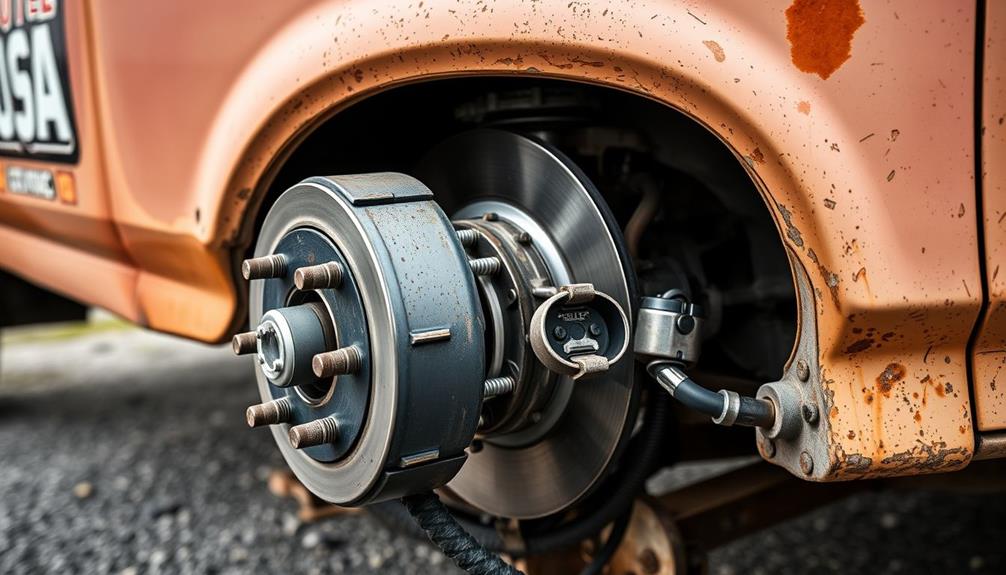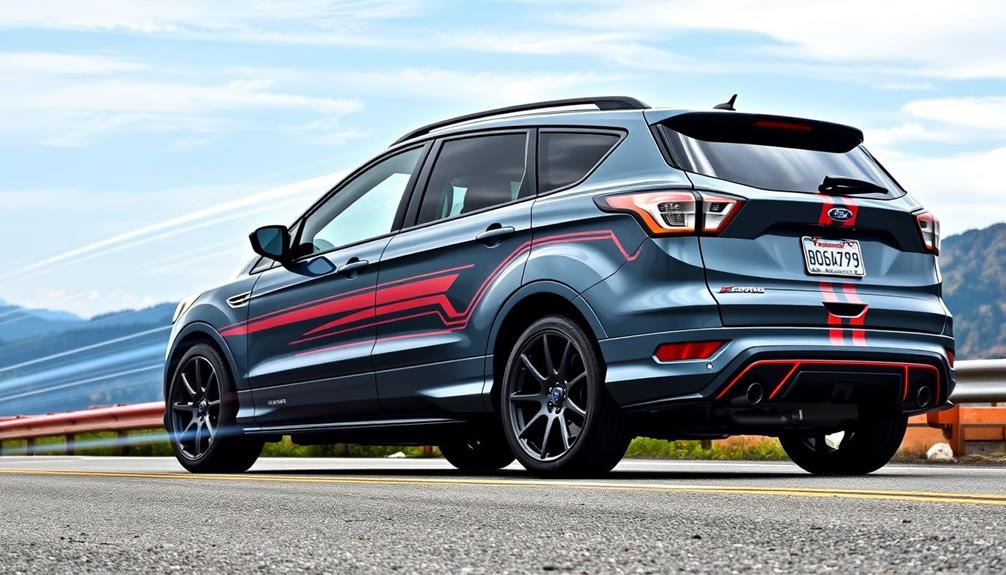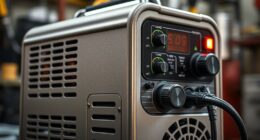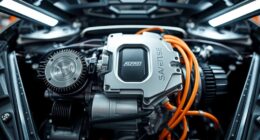Upgrading your '94 Ford Ranger with modern enhancements can transform it into a reliable workhorse while boosting performance. Start with a cold air intake and performance headers for better horsepower. Consider updating your exhaust system with a Gibson Cat-Back for improved flow. Don't overlook the suspension; Bilstein shocks and Hellwig sway bars will enhance ride quality and handling. For braking, multi-piston calipers and larger rotors improve stopping power. Additionally, modern ignition systems and LED lighting can enhance reliability. Ready to take your truck to the next level? There's plenty more tips and tricks to discover for your upgrade journey.
Key Takeaways
- Upgrade your 1994 Ford Ranger's engine with a cold air intake and headers for improved horsepower and throttle response.
- Enhance exhaust flow with a Gibson stainless steel cat-back exhaust and high-performance mufflers for better efficiency and sound.
- Improve ride quality and handling using Bilstein 5100 shocks and a Hellwig rear anti-sway bar for greater stability.
- Modernize the brake system with multi-piston calipers and larger vented rotors to boost braking performance and feel.
- Join community forums for tips and resources from fellow enthusiasts to guide your tuning and upgrades effectively.
Overview of the 1994 Ford Ranger
The 1994 Ford Ranger stands out with its robust Cologne 4-liter V6 engine, delivering 160 horsepower and 225 lb-ft of torque. This impressive power output at 4,000 RPM, combined with peak torque at a low 2,000 RPM, makes your Ranger feel enthusiastic and responsive on the road.
Weighing in at just 3,408 pounds, this truck is lighter than many of today's mid-sized models, which enhances its agility and handling.
Equipped with a 5-speed manual transmission, the Ford Ranger can handle a maximum torque input of 450 Nm (331 lb-ft), ensuring smooth gear shifts and a delightful driving experience. Its original tow capacity of 5,900 pounds showcases its utility, allowing you to haul a variety of loads, whether you're heading to the job site or starting on a weekend adventure.
Moreover, the inclusion of an Electronic Distributorless Ignition System (EDIS) improves performance and reliability, making your Ranger a dependable choice.
Engine Performance Enhancements

Upgrading your 1994 Ford Ranger's engine can release considerable performance potential, transforming your driving experience.
Start by installing a cold air intake; this simple modification enhances airflow, which can boost horsepower and improve throttle response in your Cologne 4.0L V6 engine.
Next, consider adding headers. They shift the power band, providing a mid-range performance boost while giving your truck a more aggressive exhaust note.
You might also want to port and shave the cylinder heads. This increase in compression ratio can lead to higher horsepower output and improved engine efficiency, giving you better engine torque.
Replacing the mechanical fan with an electric one is another smart move. This change can yield a power gain of 3-5 horsepower and enhance fuel economy by reducing parasitic drag on the engine.
For those looking for substantial performance gains, consider a supercharger kit for your 4.0L V6. While this upgrade can considerably enhance engine torque, be sure to tune it carefully to avoid straining your engine.
With these enhancements, your Ford Ranger will deliver a more exhilarating and efficient driving experience.
Suspension and Handling Upgrades

Upgrading your Ford Ranger's suspension can dramatically enhance ride quality and steering response, making every drive more enjoyable.
By improving off-road capability, you'll tackle rough terrains with confidence and control.
Let's explore some key modifications that can elevate your truck's performance.
Enhanced Ride Quality
When it comes to enhancing ride quality in your '94 Ford Ranger, a combination of well-chosen suspension upgrades can make a considerable difference. Incorporating upgrades can improve not only comfort but also overall vehicle performance, much like mastering the art of bug out bags enhances your preparedness for emergencies.
Here are three key upgrades that will elevate your driving experience:
- Bilstein 5100 Shocks: Upgrading to these shocks improves dampening, resulting in better handling and comfort over rough terrain. You'll notice a smoother ride on bumpy roads, which enhances ride quality markedly.
- Hellwig Rear Anti-Sway Bar: Installing a 22 mm diameter anti-sway bar drastically reduces body roll during cornering, which improves overall stability. This upgrade helps you maintain control, especially when maneuvering sharp turns.
- High Rider Coil Springs: Incorporating taller coil springs not only increases lift but also provides a smoother ride due to improved suspension travel. This added height can help tackle uneven surfaces with ease.
Together, these upgrades guarantee enhanced ride quality, transforming your classic truck into a more comfortable and capable vehicle.
Improved Steering Response
To achieve improved steering response in your '94 Ford Ranger, consider a series of strategic suspension and handling upgrades that enhance overall vehicle dynamics.
Start by upgrading to Bilstein 5100 shocks, which enhance ride quality and provide better damping control, directly contributing to improved steering response.
Next, install a Hellwig rear anti-sway bar (22 mm diameter) alongside a 23 mm front anti-sway bar. This combination increases stability and reduces body roll during cornering, leading to sharper steering feedback you'll appreciate while driving.
Additionally, retrofitting your suspension with taller coil springs from the High Rider package offers extra lift, improving ground clearance and handling, which is beneficial for various driving conditions.
For better traction and power distribution, add a True Track Torsen Limited Slip Differential. This upgrade enhances responsiveness during acceleration and turns, further promoting improved steering response.
Lastly, consider utilizing manual lock-in hubs for direct engagement of the four-wheel drive system. This allows for better control and responsiveness in challenging terrains, ensuring that your Ranger remains agile and responsive on all types of roads.
Off-Road Capability Boost
For those looking to greatly enhance the off-road capability of their '94 Ford Ranger, a series of well-planned suspension and handling upgrades can make a noticeable difference.
By transforming your Ranger into a High Rider, you'll navigate rough terrains with ease and confidence. Here are three vital upgrades to take into account:
- Bilstein 5100 Shocks: Upgrading to these shocks will considerably improve ride quality and off-road performance, giving you better control over rugged landscapes.
- True Track Torsen LSD: Installing this limited-slip differential enhances traction by effectively distributing power to the wheels, which is essential for tackling off-road challenges.
- Taller Coil Springs: Incorporating taller coil springs as part of a High Rider package will increase your ground clearance, enhancing your approach and departure angles when overcoming obstacles.
Additionally, think about retrofitting the front suspension with a Dana 35 axle and twin traction beam setup for increased durability and articulation.
Don't forget about a rear anti-sway bar upgrade, such as a Hellwig unit, to bolster stability during cornering and off-road maneuvers.
With these upgrades, your Ranger will be ready to conquer any trail!
Exhaust System Improvements

When it comes to exhaust system improvements for your '94 Ford Ranger, optimizing exhaust flow is key to releasing more power and efficiency.
You'll want to explore sound enhancement options that match your style while considering the durability of different materials.
Upgrading your exhaust system not only boosts performance but also elevates your truck's overall presence on the road.
Exhaust Flow Optimization
Optimizing exhaust flow is vital if you want to enhance the performance of your 1994 Ford Ranger. By focusing on exhaust flow optimization, you can greatly improve horsepower and torque, especially with the 4.0L V6 engine.
Understanding the importance of budgeting for upgrades will also help you allocate funds effectively for these enhancements. Here are three key upgrades to take into account:
- Gibson Stainless Steel Cat-Back Exhaust System: Upgrading to this system can dramatically enhance exhaust flow, reducing back pressure and helping your engine breathe better. This leads to noticeable improvements in fuel efficiency and performance.
- Performance Headers: Replacing stock exhaust manifolds with performance headers not only improves exhaust flow but also shifts the power band for a mid-range boost, giving you more oomph when you need it.
- High-Performance Mufflers: Installing these can further enhance exhaust flow while providing a sportier tone without being overly loud. They strike a balance between sound and performance, ensuring your Ranger sounds as good as it performs.
Don't forget that regular maintenance, like checking for leaks or blockages, is essential to keep your exhaust system working at its best.
Sound Enhancement Options
If you're looking to elevate the auditory experience of your 1994 Ford Ranger, exploring sound enhancement options within the exhaust system is a great place to start.
Upgrading to a Gibson stainless steel Cat-Back exhaust system not only enhances sound but also improves performance, giving your truck a more aggressive exhaust note and better airflow.
Installing headers can shift the power band, enhancing mid-range performance and contributing to a sportier sound while improving overall engine efficiency.
A performance exhaust system reduces back pressure, potentially increasing horsepower and torque while providing a more robust audio profile.
When considering sound enhancement options, think about the muffler design.
Chambered or straight-through mufflers allow you to customize sound levels and tone, catering to your personal preferences.
Material Durability Comparison
Upgrading your exhaust system is a smart move, especially when considering material durability. A material durability comparison reveals significant advantages when you choose a high-quality exhaust system like the Gibson stainless steel Cat-Back. The benefits are clear:
- Corrosion Resistance: Stainless steel resists rust and corrosion far better than standard mild steel, ensuring your exhaust lasts longer.
- Extended Lifespan: Stainless steel systems can last two to three times longer than mild steel, making them a wise investment.
- Enhanced Construction: Modern systems often feature superior welds and mandrel-bent tubing, which reduces back pressure and increases engine efficiency.
These enhancements contribute to a robust exhaust system that can withstand extreme conditions.
Plus, many aftermarket options come equipped with adjustable hangers and flexible joints, which help absorb vibrations and road impacts.
This attention to durability means fewer repairs and replacements down the line.
Electrical and Ignition Upgrades

When it comes to enhancing your 1994 Ford Ranger's performance, electrical and ignition upgrades play an essential role. Upgrading the ignition system can greatly boost your truck's efficiency.
Consider replacing the original components with high-output coils and performance spark plugs. This will improve ignition efficiency and power delivery, giving you better throttle response.
Installing a high-performance electronic ignition system can also provide better timing accuracy and increased energy output, leading to smoother engine operation.
To further enhance your electrical system, adding a dedicated battery for the ignition can help eliminate voltage drops, ensuring consistent performance, especially during demanding situations like off-roading.
You should also think about utilizing a modern wiring harness. This simplifies electrical connections, reduces potential failure points, and improves overall reliability.
Additionally, incorporating LED lighting for both interior and exterior applications not only enhances visibility but also reduces the electrical load on your system. This contributes to better fuel efficiency, making it a smart upgrade.
These electrical and ignition improvements won't only modernize your Ranger but also elevate its performance on and off the road.
Brake System Modernization

Modernizing the brake system of your 1994 Ford Ranger can greatly enhance its stopping power and reliability. Upgrading components not only improves performance, but it also guarantees a safer driving experience.
Here are three essential upgrades to contemplate for effective brake system modernization:
- Multi-Piston Calipers: Replace the original single piston calipers with modern dual or multi-piston calipers. This change boosts braking performance and provides a better pedal feel, enhancing modulation and responsiveness.
- Larger Vented Rotors: Install larger, vented rotors to increase surface area and improve heat dissipation. This upgrade helps prevent brake fade, especially during heavy use, guaranteeing consistent performance.
- Braided Stainless Steel Brake Lines: Switch to braided stainless steel brake lines. These lines reduce fluid expansion under pressure, delivering a firmer pedal feel compared to rubber lines.
Additionally, contemplate installing a brake booster from a newer model to enhance pedal travel and reduce effort, especially when towing or off-roading.
A rear anti-sway bar can further complement these upgrades, enhancing stability during braking. By implementing these changes, you'll dramatically improve your Ranger's brake system.
Tire and Wheel Considerations

Choosing the right tires and wheels for your 1994 Ford Ranger is vital for maximizing performance and handling. Start by considering the original wheel size of 15×7 inches, which can accommodate wider tire sizes for improved traction and stability.
If you're looking to enhance off-road capability, increasing your tire size can be advantageous, but make certain the new tires don't exceed the wheel well clearance to avoid rubbing during turns.
A good rule of thumb is to maintain an aspect ratio that keeps the overall diameter similar to the original. This prevents speedometer inaccuracies and maintains ride quality. Popular tire sizes for off-road performance range from 31 inches to 33 inches, especially if you opt for all-terrain or mud-terrain tires, which greatly improve your Ranger's capabilities on rough terrain.
Additionally, pay close attention to wheel offset and backspacing. These factors are important to guarantee that wider tires don't interfere with your suspension components or body parts when you're maneuvering.
With careful consideration of tire size and wheel specifications, you can elevate your Ranger's performance while keeping it functional and reliable.
Community Tips and Resources

With over 9.5K threads and 44.7K messages, the community forum dedicated to the 1994 Ford Ranger is an invaluable resource for enthusiasts looking to enhance their trucks.
Here, you'll find a wealth of knowledge and experience on tuning and modifications. Members actively share personal experiences and practical tips, helping you make informed decisions about upgrades.
Additionally, it's important to avoid scams when investing in aftermarket parts. Here are three community tips to take into account:
- Performance Upgrades: Explore discussions on cold air intakes and exhaust systems that can greatly boost your truck's horsepower and torque. Members often detail their own setups and results.
- Technical Library: Don't forget about the Technical Library, where you can find and even submit technical articles. This is a great way to gain insights into tuning and restoration projects directly from fellow enthusiasts.
- Engagement and Inspiration: Participate in active forums, especially in the Off-Road & 4×4 section. Sharing photos and modifications fosters a collaborative environment, providing you with inspiration and guidance for your own upgrades.
Frequently Asked Questions
How Much Horsepower Does a 94 Ranger Have?
Your 1994 Ford Ranger has 160 horsepower at 4,000 RPM. With a 4.0L OHV V6 engine, it delivers solid performance, especially for towing and off-road driving, thanks to its strong low-end torque.
What Is the Best Year for Ford Ranger Pickups?
When considering the best year for Ford Ranger pickups, you'll find many enthusiasts favor the 2001 and 2003 models. They offer a perfect mix of modern features and classic appeal, enhancing your driving experience remarkably.
What Is the Weakness of the Ford Ranger?
The Ford Ranger's weaknesses include its low horsepower, outdated braking system, and manual locking hubs. You might find the bench seat uncomfortable during long drives, which can affect your overall driving experience considerably.
Can I Put Premium in My Ford Ranger?
Sure, you can put premium in your Ford Ranger, but it's like dressing up for a casual picnic. You won't gain much performance, and you'll just end up spending more without any real benefits.
Conclusion
By tuning your '94 Ford Ranger, you're not just enhancing a classic; you're breathing new life into it, like giving an old book a fresh cover. Modern upgrades can transform its performance and reliability, making every drive feel exhilarating. Whether you're hitting the trails or cruising the streets, these enhancements will guarantee your Ranger stands out and runs like a dream. So plunge in, embrace the journey of restoration, and enjoy the ride! Consider adding some modern power upgrades to your ’94 Ford Ranger to really take it to the next level. With the right modifications, you can unleash its full potential and experience a whole new level of driving pleasure. From upgraded engines to performance exhaust systems, the possibilities are endless for transforming your Ranger into a powerhouse on the road. Don’t hesitate to explore the world of modern power upgrades and take your classic Ford Ranger to new heights. With advancements in automotive technology, there’s no reason your vintage Ranger can’t benefit from some of the same innovations seen in luxury vehicles today. In fact, some enthusiasts look to *Porsche Macan GTS tuning* for inspiration, borrowing performance-enhancing techniques to revitalize their own builds. By integrating these ideas with your Ford Ranger’s upgrades, you’ll be combining rugged heritage with cutting-edge precision, resulting in a unique driving machine that’s truly one-of-a-kind.









